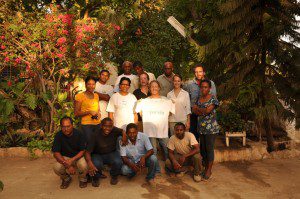By Charlie Gough, Marine Research Coordinator, Belo-sur-mer, Madagascar. The last week of November, and the dust bowl city of Toliara was the location for the 1st Parfish workshop to be held in Madagascar. Parfish, a participatory approach to stock assessment, uses Bayesian statistics (a statistical assessment of probability) to rapidly assess fisheries stocks based on fishers’ traditional knowledge of catch rates and fishing effort in their area.
Participants representing various NGO’s and institutions from the region including WWF, Blue Ventures, Reef Doctor, IHSM, MNP, and Service de Pêche met together in Toliara with the Parfish representatives Suzannah Walmsley and Paul Medley. The first day set the bar high for the rest of the training with explanations of probability modelling and statistical analysis, awakening distant memories of mathematics classes long since forgotten for many of the students.
With Parfish being a participatory approach, however, there was rarely a dull moment to the course as the statistical explanations were frequently interrupted by hands-on examples of how the rules of probability work in the real world.
Parfish uses games such as; “guess the number of oranges” to explain how observation increases the accuracy of our estimations, the “fishing experiment” (a cardboard box full of scrunched up paper and ping pong balls representing fish) to help explain the depletion of a resource and the “bau game” (known to the Malagasy as Kanga), which helps us to explain overfishing in relation to reproduction.
These games got the students up and about laughing at teach other, a good sign that they would also be useful in later explaining the need for monitoring fisheries resources to local communities.
One of the next games was that of the preference or choice experiments, which identifies the current level of fishing effort of the fisher and his current catch, as each consecutive card is weighed against his current status, the fisher is asked to decide which he would prefer of the two scenarios before him and the cards are placed on a binary tree based on his preferences. These preferences allow us to determine how the community might respond to certain management strategies.
Following the first 3 days of the training it was time to put into practice what had been learned, and so WWF packed up the students and whisked them off to the small coastal village of Befasy, in the commune of Beheloke, where the village of blissfully unaware fishermen were enjoying a hazy Monday afternoon.

Local fishermen try their hand fishing for Ping pong balls in the Parfish fishing experiment, Befasy
The WWF team has been working in the village of Befasy for some years and so called together the community members in a ‘fokonolona’ meeting to explain why 13 strangers had arrived in their small town.
The “guess the oranges” (now transformed to mangoes) game was brought out to help explain to the community the need for surveying, and following on from this the fishing experiment to show how fishers can deplete a resource. This last game caused quite a stir with the crowd as ping pong balls and paper flew everywhere. After further explanations of the surveys and preference cards, the WWF team of socio-organisers explained to the villagers that we would return the next day to start carrying out the surveys, and asked that the villagers support us in this experiment in an effort for all of us to learn more about the status of the reef fisheries of Befasy.
The following day we returned to the village armed with fish preference cards and questionnaires. The morning was spent with the large group of students consecutively trying their hand at asking one of the village elders the questions about his fishing activities and preferences. And in the afternoon, feeling a little more prepared the team broke up into smaller groups to trial the interviews and preference tests with other fishermen in the village.
The interviews went well with the fishermen, and the teams quickly identified areas for improvement in the methods and explanations. All in all the trip went well and we left having completed 12 interviews, plenty for a trial analysis when we returned to Toliara the next day.
The data entry and analysis is simple to complete, and the programme developed by the Parfish team allows quick analysis and interpretation of the results.
The final day was spent interpreting the results of the interviews and discussing the use of other more traditional methods of stock assessment such as landings surveys. While Parfish allows a rapid assessment of the fishery when little or no other data is available it is advised to instigate other monitoring methods alongside Parfish as this will help build a more accurate estimation of the fisheries stock. Overall, the workshop was a huge success and Blue Ventures will be trialling the newly acquired Parfish methods and ideas alongside routine fish landings surveys in the New Year.


